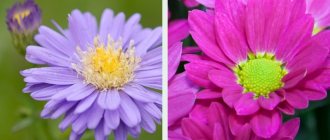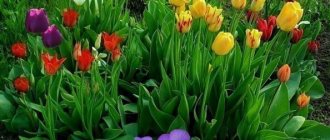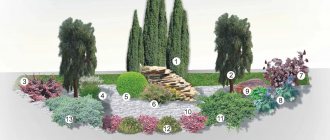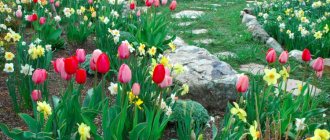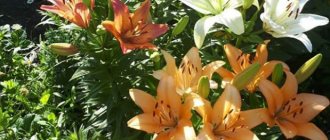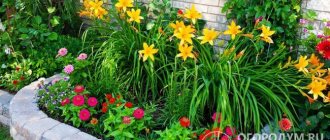Marigolds (in Latin Tagetes, popularly also called blackbrews) in many countries are considered the flowers of the sun and long life. They belong to the universal annual and perennial plants that are found in almost every country flower garden. All this is explained by their versatility, ease of care, long flowering until the first frost, bright colors that make flower beds expressive and colorful.
Using marigolds in landscape design
Flower beds with marigolds are actively used by landscape designers and florists. Here you can find not only classic simple varieties, but also terry ones, in all possible shades (red, yellow, orange). Thanks to the efforts of breeders, marigolds differ not only in the shape of the flowers and their colors, but also in height. They are: high, medium and low.
Attention : not only flowers, but also patterned leaves are considered decorative among marigolds.
Also in gardening, different types of marigolds are used: erect, thin-leaved, rejected. All of them differ in their decorative qualities and flowering duration. Some varieties are able to bloom until the first frost.
Florists use marigolds in landscape design for:
- bright accents on flower beds and adding contrast;
- achieving a lace effect;
- camouflage withered and faded flowers;
- filling voids in flower beds;
- decoration of paths, platforms, alleys.
Many summer residents are interested in the question: how to beautifully plant marigolds so that they become a real decoration of the garden, lawn or recreation area. It's as simple as that. They fit harmoniously into various stylistic trends, and look equally expressive both in nostalgic classical compositions and in modern landscapes.
Chernobryvtsy are also used for planting in containers, pots, stone flower beds, carts, and so on. They look beautiful both in mono plantings and in various flower arrangements. These plants are completely unpretentious to care for. They can be replanted even during the flowering period, and at the same time, they will not lose their buds and will delight you with bright flowering. The only thing is that Chernobryv residents do not like shade. However, even in very dark corners of the garden they grow, develop, and bloom well (just not as brightly as in the sun).
A flowerbed of marigolds in the garden can consist only of these flowers, but of different varieties, and can be supplemented with other plants. With a competent approach to creating a flower garden, experienced gardeners with creative thinking and a creative approach to business form original and truly fabulous flower beds on the site in the form of the sun, various animal figures, and so on.
Budget flower beds for summer residents
An inexpensive and quick way to create a flower garden at your dacha with your own hands is to use scrap materials and unnecessary items. Any stones, bricks, pebbles are suitable for decorating flowerbed borders.
They are left natural or painted in bright colors.
A budget option is to use saw cuts or stumps to create a flower bed of annual flowers with a small root system.
This is how you can decorate flower beds with tulips, pansies, and petunias. To make such a flower garden with your own hands, you need:
- Choose a stump or cut that is not rotten or damaged by insects.
- Use a saw or chisel to make a recess in it, leaving 5 cm around the circle untouched.
- Coat the wood with an antiseptic compound.
- Make drainage in the form of drilled inclined holes on the walls. Place a layer of gravel on the bottom.
- Fill the structure with soil and plant the selected plants.
Video instruction:
Other wooden products are also suitable for decorating a flower garden - pegs, logs, sawdust, branches. For example, you can weave baskets from willow branches and use them as containers for flowers.
In much the same way as from a stump, you can create flower beds from various old things - carts, boats, cars, cages, TVs, barrels, any damaged furniture.
If the area of the summer cottage is small, then small flower beds can be made from a watering can, suitcase, old bags, bottles, glass or plastic plates.
A painted car tire makes a bright flower bed, and boxes and pallets make the basis for creating a multi-tiered flower garden.
Beautiful combinations of flower beds
Beautiful flower beds are obtained by using interesting combinations in the composition not only of plant varieties, but also:
- by color - gradient, contrast, similar shades;
- in form - smooth chaotic lines, strict geometric shapes, ornaments;
- additional elements.
You can successfully play with a variety of objects, making them the central element of the flower garden, its base or border. These can be the already described budget options or, for example, a bridge, a garden fountain, a bench around which flowers are planted.
Volumetric flower beds always look beautiful. To create them, taller flowers are planted in the center, then lower ones, and ground cover varieties are planted at the edges.
Alyssum
Such a flowerbed can be made in an old tire, barrel, or box. By analogy with size, you can use another plant parameter - color: plant dark blue flowers in the center, then blue, and white at the edges.
Primrose and irises in a flowerbed
An interesting option is a stone garden. This is the name of a flower garden that is grown on stones. They are fixed with lime mortar or laid out on a designated area randomly or in accordance with a pre-planned pattern.
Plants, edible greens, and herbs are planted in the spaces between the stones. Often such compositions are complemented by shrubs and trees, especially if a rather large area is allocated for the garden.
Description of colors
America is the homeland of marigolds. They were brought to Europe in the 16th century. And in Russia, Chernobryvtsy were considered the first overseas flowers. In nature, there are more than 40 species of marigolds, ranging in height from 20 cm to 1 m. Their seeds give good germination. And the spicy smell comes not so much from the buds, but from the leaves.
SMART CHOICE
When selecting summer plants for spring planting, you should not buy all the seed packets with the photos you like in a row. First, evaluate your capabilities: can you grow them without unnecessary hassle?
It is better for an inexperienced or busy gardener to pay attention to those species that are sown directly into the ground. These are: pink helipterum (acroclinum), calendula, cosmos, clarkia, lavatera, annual poppies, matthiola, blue cornflower, godetia, dimorphotheca, eschscholzia, venidium, nemesia, iberis, mignonette, etc. In central Russia you can go straight to the flower garden sow some “seedling” crops - callistephus (annual aster), marigolds, especially b. rejected, helychrysums, zinnias, Drummond phlox, sweet peas and some other species, but in this case their flowering will come late, only in the second half, or even at the end of summer.
Crops grown through seedlings are somewhat more complex than the previous ones. However, they, in turn, can also be divided into several groups. Seedlings of such species as marigolds, zinnias, amaranths, annual dahlias, coleus, celosia, and annual chrysanthemums are the easiest to grow.
Their seeds are sown in boxes (on window sills, loggias) or in the soil of greenhouses in mid-April, and planted in the ground at the end of May, when the threat of return frosts has passed.
The next group of summer growers has a longer period of obtaining high-quality seedlings and requires a little more patience and experience.
Their seeds are sown about a month earlier - in mid-March, boxes with crops are placed on light windowsills or in greenhouses.
Such crops include ageratum, alyssum, arctotis, annual aster, verbena, gatsania, Chinese carnation, helichrysum, sweet pea, kochia, gillyflower, lobelia, snapdragon, perilla, petunia, salvia, sweet tobacco, Drummond phlox.
And finally, the last group includes species that have the longest period of development in seedlings. They are sown in January - February in heated greenhouses or indoors on special racks with light installations.
For the first month or two, boxes with crops and seedlings must be illuminated with special lamps, since otherwise the seedlings stretch out and die. Such crops include: Chabot carnation, tuberous begonia, viola (Vitrocca violet), statice, heliotrope, fuchsia and some other species. I would not recommend growing them from seeds to inexperienced gardeners.
Main varieties
There are several varieties of marigolds, on the basis of which new varieties with large or small flowers, double or regular petals are constantly being developed. But they all have a brown, yellow, red or orange tint.
Attention: breeders have managed to develop unique marigolds - white in color.
Rejected marigolds (Tagetes patula)
This is a low-growing group of marigolds, which are also called French, small-flowered or spreading. Their bushes are unstable and often bend downwards. Their height varies from 15 cm to 60 cm. Their central shoot is erect, and the side shoots are deviated (hence the name of the group). The shoots branch heavily, so the bushes are usually wide.
The leaves of rejected marigolds are pinnate and small, with jagged edges and dark green in color. They come in pairs and alternating. The flowers of these varieties are single and collected in inflorescences. And the petals can be simple or double. Typically, these varieties have two to three colors, and monotonous colors are rare. Common colors are lemon and dark brown. Their flowering begins in June and continues until September. Popular rejected varieties are: Carmen, Bonanza Bolero, Bonanza Orange.
Tagetes erecta
Despite the fact that their homeland is Mexico, in people and literature they are usually called African. This group reaches a height of 50 cm to 1 m. They have a fibrous root system, shoots are straight and directed upward (hence the name erect). The leaves are unpaired, toothed and dark green. Their inflorescences are usually monochromatic, although there are also two-color ones, with a diameter of 5 to 12 cm. Petals can be either double or simple. They bloom from early July until mid-autumn. They are among the largest blackbirds, and their common varieties are: Antigua, Kilimanjaro, Vanilla.
LAVATERA
The colorful Lavatera trimestris (Lavatera trimestris) always attracts attention in the garden. But not only for this is why gardeners love her so much, but also for her long, abundant flowering and flexible character. Lavatera is a fairly powerful, branched, fast-growing plant with a height of 60 to 150 cm. During flowering, from late June to autumn, it is covered with large (6–10 cm in diameter), funnel-shaped flowers, painted white, pink or red.
Lavatera three month old 'Novella'. Photo: AiF/ Elena Kolesnikova
Where to plant?
Long-lasting, generous, bright flowering and unpretentiousness make Lavatera desirable for any flower garden - flower bed, border, border, mixborder. The flowers stand well as cut flowers. Compact varieties can be used to decorate containers or garden vases.
Lavatera three months old 'Mont Blanc'. Photo: AiF/ Elena Kolesnikova
How to grow?
Lavatera is cold-resistant, light-loving, drought-resistant, and does not like waterlogging. It grows well in a variety of soils, but feels better and blooms more profusely in light, fertile soils.
Seeds are sown directly into the ground in early May, in nests of 2–3 seeds at a distance of 25–30 cm. It is also possible to sow seeds in a line at a distance of 10–15 cm from each other. In dry weather, plants must be watered, otherwise their growth will slow down and flowering will not be abundant. In May - June, it is advisable to carry out 3-4 fertilizing with complex fertilizers at intervals of 10-15 days.
What's in a name?
Lavatera received its name in honor of the Lavater brothers, famous German doctors and naturalists.
Marigold flowerbeds
Chernobryvtsy look original in:
- monoflowers;
- mixborders;
- in open areas;
- as borders along fences;
- as paths through walking areas.
When designing a monoflower bed, you can use any simple geometric shapes: circle, oval. The tallest varieties are planted in the center, and then as the height decreases. When creating contrasting flower beds, various ornaments and designs can be formed in the flower beds. Chernobryvtsy planted along paths and alleys look very impressive. For this purpose, low-growing varieties are used. And to create unusual flower beds, designers combine marigolds with conifers. For example, in the middle of the flowerbed there is a spectacular thuja or juniper, and they are surrounded by a dense ring of bright blackbrows.
When designing marigold flower beds, consider the following:
- the color scheme should not be too contrasting;
- annual marigolds are used as a complement to perennials;
- Chernobyvtsy look beautiful against the background: petunias, dahlias, phloxes, asters, zinnias.
As for stylistic directions, then:
- in English squares, Tagetes bring a sunny mood;
- in Italian parks they delight with a riot of colors and bring a solemn and elegant look;
- In country music, marigolds add uniqueness to landscape designs.
Attention: several flower beds sown with one variety of marigold look very impressive. It is recommended to place them either at the same level or in a cascade.
Garden work
First you need to get the dimensions of the plot. Then decide on the shape and functional purpose of the flower bed. In order not to worry too much about the accuracy of the form, you can use a cunning design move. Place an inverted bucket or barrel in the center of the flowerbed (decorate it beautifully). From this item, make several beds that will expand and twist figuratively. You will get a flowing waterfall of flowers.
The color scheme can be monochromatic or alternating. For example, one stripe of bright red petunias, followed by yellow flowers and a stripe of blue cornflowers. If the size of the plot does not allow you to create a large flower bed, you can arrange single flower beds that will rise somewhat above the ground. Or you can place pots of flowers around the house. A plant planted in a large old shoe or boot looks very interesting.
An improvised sun with rays looks impressive: in the center there is a circle of yellow plants, from which expanding rays of the same size of other colors diverge in different directions. For more sophisticated natures, we can recommend a flowerbed designed in the style of symmetrical geometry.
To make it easier to imagine the border between the figures of one flowerbed, you can sprinkle gravel or sand between the beds and pave the free space with decorative stones. This way the flowerbed will not look like a chaotic collection of flowers, and the pattern will be noticeable from the very beginning.
Before planting the plants, it is necessary to dig up the flower bed and fertilize it with compost. This is done in March or April. It is best to plant ready-made flower seedlings in April or May. But some plants do not tolerate or do not cope well with transplantation, so such flowers can be planted with seeds in open ground in the spring. True, there is no complete confidence that the shoots will be friendly.
After decorating the flower garden, you will definitely need to thin out the flowers and remove weeds. Usually such work is carried out at the end of May. During this same period, the first plants will fade and their inflorescences will need to be removed so that they do not spoil the whole picture. Tall plants must be tied up or a beautiful design support must be invented for them. It is better to water flowers early in the morning or in the evening, after the sun has set. If you water at lunchtime, the scorching sun will kill the plants.
This is how easy it is to design a garden flower bed. To do this, you need to use your imagination and use important planting rules.
Combination of marigolds with other flowers
Marigolds combine beautifully with different plants:
- asters;
- phlox;
- petunia;
- dahlias;
- cineraria;
- zinnias and so on.
li>sage;
They can be combined with both perennials and annuals.
Attention: flower beds made from asters and marigolds of different varieties look very beautiful.
Keep in mind that when forming flower beds from different types of plants, the following factors are taken into account:
- identical crop requirements for light, soil composition and frequency of watering;
- size and shape of flowers (they should not interfere with each other’s growth);
- time for buds to open.
Also, when creating flower beds with marigolds and other flowers, it is important to take into account their decorative properties depending on weather conditions and time of day. That is, some flowers close their buds in sunny weather, others open them.
Schemes of flowerbeds of marigolds and petunias
Marigolds and petunia in the same flowerbed are a wonderful combination. Fragrant and long-blooming flowerbeds of multi-colored petunias, together with marigolds of different colors, will become a magnificent decoration of any garden or recreation area.
A container flower bed is a good choice, as petunia grows well in closed soil. By planting plants in containers, you can form a vertical flower garden of several tiers. For this purpose, petunias should choose pink or purple shades, and marigolds should be erect and yellow.
This elegant flower bed can be used to decorate the entrance area, patio or the edge of the lawn.
Attention : when combining flowerbeds of marigolds with petunia, it is worth considering that petunia is a short flower. Therefore, low-growing blackbrows should be planted with them.
Round flower bed of marigolds and coleus
Typically, round and oval flower beds are considered the simplest and are most often classified as monobeds. When forming a round flower garden with marigolds and coleus, you should adhere to the following recommendations:
- tall varieties are planted in the center, then medium in height and the lowest along the outer edge;
- When forming a round flower bed, you can show your imagination and depict an ornament in the form of the sun, waves, bends, stripes.
When forming a flower bed of blackbrows and coleus, you can add a little petunia in dark pink and purple tones. They are planted in a circle and the center is filled with orange marigolds. To ensure that the flower bed has a clear shape and contour, low-growing coleus are planted as a border.
Flower schemes
To make it easier to navigate when creating your own scheme, we suggest that you familiarize yourself with several simple but beautiful ready-made options.
Table. Flower bed schemes.
1 – annual stock roses of three colors (white, red, yellow); 2 – decorative sunflower; 3 – Spanish poppy; 5 – cardinal lobelia; 6, 7, 8 – bell, catnip; 10 – sedum. The remaining flowers can be selected in accordance with the color indicated in the diagram.
Flowerbed cake: 1 – low red flowers; 2 – white or silver flowers; 3 – medium-sized plants with red flowers; 4 and 5 – high background crops.
Round flowerbed: 1 – cannas; 2 – begonia; 3 – petunia; 4 – snapdragon; 5 – marigolds; 6 – alyssum; 7 – ageratum; 8 – pyrethrum.
1 – amaranth; 2 – zinnia; 3 – garden quinoa; 4 – chard; 5 – basil; 6 – nasturtium.
What plants should not be planted with?
Despite the fact that marigolds get along well with various plants in landscape design, there are still crops with which they should not be planted too close. Chernobryvtsy, along with a smell that repels pests, also release substances that can inhibit the development of certain crops: peas, radishes, beans. It is also believed that Chernobyvtsi have a negative effect on rose gardens.
RAISING "Virgin Land"
Summer gardens are especially useful when you are going to start a flower garden in a new area with uncultivated soil. Many novice flower growers have the opinion that it is better to start with perennial plants: they say, once you plant them, no worries. But what is really happening? After all, even if you don’t get involved with capricious crops, of which there are quite a few among perennials, but plant the most undemanding species and varieties, but in a poorly prepared place, then:
– in flower beds of perennial plants, you do not have the opportunity to dig the soil deeply with the addition of organic fertilizers and thereby improve it;
– weeds, the seeds and pieces of rhizomes of which are difficult to get rid of in one digging of the soil, are intertwined with roots with cultivated plants, and removing them can be very difficult;
– in new areas it is difficult to immediately plan flower beds, and moving perennial bushes from place to place is often not very easy.
The second piece of advice naturally follows from this: start “developing virgin soil” by planting annual flowers. Indeed, as a result of autumn or spring digging of flower beds with the addition of organic matter, you can significantly increase the fertility and structure of the soil and clear the area of most weeds.
Calendula medicinal series 'Pacific'.
Caring for marigolds
Marigolds are heat-loving plants, so they should be planted in sunny areas. They also grow in the shade, but it is advisable that daylight hours last for at least 6 hours. Plants feel comfortable at an air temperature of +20 degrees.
It is worth noting that marigolds in pots in the garden tolerate drought well and can go without water for a long time. But excessive watering is strictly prohibited for them, as it leads to rotting of the root system.
The process of caring for marigolds in the country is minimal, and comes down only to weeding and loosening the soil. These flowers do not require regular and abundant watering or fertilizing. The only thing is that if there is abundant flowering, it is recommended to remove faded inflorescences and cut off excess side shoots.
To summarize, we can note that we looked at how to beautifully plant marigolds on a plot, what varieties they come in, which plants are combined with and which ones are not. From all of the above, we can conclude that a flowerbed of marigolds can decorate any garden plot, since it is colorful, original and easy to care for.
Cultivation
How to plant marigolds? This question interests all novice summer residents. The main advantage of these flowers is their unpretentiousness. In some cases, you can replant a large bush of a plant, which will take root in a new location. When to plant marigolds?
The first step is to prepare seeds for planting. They are collected in late autumn, after the flowering process. Planting material must be stored in a dark and cool place. You should also avoid high humidity, which can cause mold.
When to plant marigolds in the ground? The planting process is carried out in the spring, when the soil has finally warmed up. Most experienced gardeners prefer to grow flower seedlings first. To do this, place dry seeds in a small pot of soil. After some time, shoots appear.
Planting and caring for marigold flowers does not require much effort. Marigolds are planted in the ground at a shallow depth of 5-8 cm. Do not bury these flowers too deeply. The root collar should be at ground level.
The main requirement of this breed is timely watering. As a rule, it is carried out as the earthen coma dries out.
The presence of weeds in the flowerbed among these flowers is not welcome. The fact is that they can have a negative impact on the growth process of this crop, creating shaded areas in the flowerbed.
Continuous flowering
The greatest effect can be achieved if both annual and perennial plants are combined in the flowerbed. This will allow you to get continuous flowering of the flower bed from May until frost.
Perennial flowers have undeniable advantages. They only need to be grown and planted once. And with proper, simple care, these plants, growing every year, will delight you with their flowering for a long time. You can grow perennial plants from seeds yourself, you can buy the root in the store, or you can ask your neighbor. The latter is preferable for a beginning gardener. The root is already adapted to the climatic conditions of the region. With some skill, you can dig up a plant with a large lump of earth, so that it will not notice the “moving”, which means it will continue to grow and bloom on your site without loss. Now you have another reason to visit your neighbors or visit a friend’s dacha.
When planning a flowerbed of continuous flowering, be sure to plant lupine and bearded irises. And already in June your flowerbed will glow with multi-colored lupine candles and unusual iris flowers among the emerald greenery of spring. Palms of lupine leaves collected in a clump and the succulent feathers of the foliage of faded irises will look aesthetically pleasing in the flowerbed until late autumn. The picky, shade-tolerant Turkish carnation and the bright red lychnis will join in the flowering dance. Powerful, long-blooming foxglove candles and the finest butterflies of eschscholzia flowers will bloom almost at the same time. Using this, you can create an original duet based on the contrast of shape and color combination.
In July, a real parade of flowers begins! Many annuals are blooming: lavatera, cosmos, salvia, Drummond's phlox, cornflower, poppy, calendula, nasturtium, godetia, marigolds and others. Perennials - dahlias, lilies, gladioli - are gaining strength.
By the way, now in the store you can buy dahlia tubers, gladioli bulbs, and lily bulbs. By planting them on your site in May, you will enjoy the flowering of perennials this summer. But remember, dahlias and gladioli need to be dug up for the winter. Lilies can grow for several years without transplanting.
For the future
We need to take care of the next season this summer. Sow perennials: cornflower, gaillardia, echinacea - and next year you will have a beautiful “chamomile” flower garden. To start flowering in early spring, buy bulbs of crocuses, muscari, hyacinths and tulips in the fall. And already in April the area will be illuminated with delicate crocuses. Then the muscari “cobs” will turn blue, then the baton of flowering will be picked up by luxurious fragrant hyacinths and diverse tulips. Pushkinia, scilla, chionodoxa, daffodils, hazel grouse, hellebores. Over time, you will be able to collect a complete collection of early spring flowers.
For the future: it is advisable to plant bulbous plants in close proximity to perennials with powerful foliage. For example, between peonies, ferns or hostas. In early spring, when the greenery of perennial plants has not yet grown, bulbous plants can show themselves in full glory. And then the slowly drying leaves of primroses will be covered by perennials.
Take a closer look at the spectacular and unpretentious perennials: peony, heuchera, catnip, chickweed, astilbe, daylily, liatris, lupine, fern, hosta, bergenia, gypsophila, irises, lilies, decorative onions. Choose your favorites and go for it! And then experience will accumulate, there will be more and more flowers and your unique garden will become more colorful and richer every year!
And lastly: take pictures of your flower beds and take pictures of yourself with your flowers. On dreary November evenings, these photos will warm you up, bringing back the warmth and love with which you raised your pets. Good luck!
Beneficial features
Marigolds are valuable not only for their decorative properties, but also for their beneficial properties. They are the best option for introducing into mixed beds (mixed plantings of flowers and vegetables) and for growing together in tea and spice plantings. Their green parts and roots produce natural phytoncides, which contributes to additional protection of garden crops from damage by plant infections, nematodes and fusarium.
Their rich aroma drives away insect pests, moles and mole crickets - these formidable enemies of garden crops.
